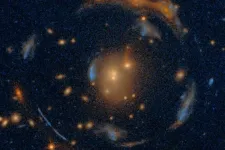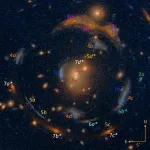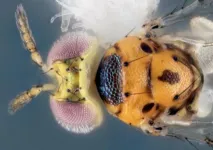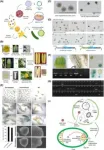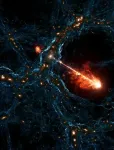(Press-News.org) In a rare and extraordinary discovery, researchers have identified a unique configuration of galaxies that form the most exquisitely aligned gravitational lens found to date. The Carousel Lens is a massive cluster-scale gravitational lens system that will enable researchers to delve deeper into the mysteries of the cosmos, including dark matter and dark energy.
“This is an amazingly lucky ‘galactic line-up’ – a chance alignment of multiple galaxies across a line-of-sight spanning most of the observable universe,” said David Schlegel, a co-author of the study and a senior scientist in Berkeley Lab’s Physics Division. "Finding one such alignment is a needle in the haystack. Finding all of these is like eight needles precisely lined up inside that haystack."
The Carousel Lens is an alignment consisting of one foreground galaxy cluster (the ‘lens’) and seven background galaxies spanning immense cosmic distances and seen through the gravitationally distorted space-time around the lens. In the dramatic image below:
The lensing cluster, located 5 billion light years away from Earth, is shown by its four brightest and most massive galaxies (indicated by La, Lb, Lc, and Ld), and these constitute the foreground of the image.
Seven unique galaxies (numbered 1 through 7), appear through the lens. These are located far beyond, at distances from 7.6 to 12 billion light years away from Earth, approaching the limit of the observable universe.
Each galaxy’s repeated appearances (indicated by each number’s letter index, e.g., a through d) show differences in shape that are curved and stretched into multiple “fun house mirror” iterations caused by the warped space-time around the lens.
Of particular interest is the discovery of an Einstein Cross – the largest known to date – shown in galaxy number 4’s multiple appearances (indicated by 4a, 4b, 4c, and 4d). This rare configuration of multiple images around the center of the lens is an indication of the symmetrical distribution of the lens’ mass (dominated by invisible dark matter) and plays a key role in the lens-modeling process.
Light traveling from far-distant space can be magnified and curved as it passes through the gravitationally distorted space-time of nearer galaxies or clusters of galaxies. In rare instances, a configuration of objects aligns nearly perfectly to form a strong gravitational lens. Using an abundance of new data from the Dark Energy Spectroscopic Instrument (DESI) Legacy Imaging Surveys, recent observations from NASA’s Hubble Space Telescope, and the Perlmutter supercomputer at the National Energy Research Scientific Computing Center (NERSC), the research team built on their earlier studies (in May 2020 and Feb 2021) to identify likely strong lens candidates, laying the groundwork for the current discovery.
“Our team has been searching for strong lenses and modeling the most valuable systems,” explains Xiaosheng Huang, a study co-author and member of Berkeley Lab’s Supernova Cosmology Project, and a professor of physics and astronomy at the University of San Francisco. “The Carousel Lens is an incredible alignment of seven galaxies in five groupings that line up nearly perfectly behind the foreground cluster lens. As they appear through the lens, the multiple images of each of the background galaxies form approximately concentric circular patterns around the foreground lens, as in a carousel. It’s an unprecedented discovery, and the computational model generated shows a highly promising prospect for measuring the properties of the cosmos, including those of dark matter and dark energy.”
The study also involved several Berkeley Lab student researchers, including the lead author, William Sheu, an undergraduate student intern with DESI at the beginning of this study, now a PhD student at UCLA and a DESI collaborator.
The Carousel Lens will enable researchers to study dark energy and dark matter in entirely new ways based on the strength of the observational data and its computational model.
“This is an extremely unusual alignment, which by itself will provide a testbed for cosmological studies,” observes Nathalie Palanque-Delabrouille, director of Berkeley Lab’s Physics Division. “It also shows how the imaging done for DESI can be leveraged for other scientific applications,” such as investigating the mysteries of dark matter and the accelerating expansion of the universe, which is driven by dark energy.
Learn more:
The Carousel Lens: A Well-modeled Strong Lens with Multiple Sources Spectroscopically Confirmed by VLT/MUSE – August 19, 2024 / William Sheu et al / The Astrophysical Journal
View the Carousel Lens in the DESI Legacy Survey Viewer.
###
Lawrence Berkeley National Laboratory (Berkeley Lab) is committed to delivering solutions for humankind through research in clean energy, a healthy planet, and discovery science. Founded in 1931 on the belief that the biggest problems are best addressed by teams, Berkeley Lab and its scientists have been recognized with 16 Nobel Prizes. Researchers from around the world rely on the lab’s world-class scientific facilities for their own pioneering research. Berkeley Lab is a multiprogram national laboratory managed by the University of California for the U.S. Department of Energy’s Office of Science.
DOE’s Office of Science is the single largest supporter of basic research in the physical sciences in the United States, and is working to address some of the most pressing challenges of our time. For more information, please visit energy.gov/science.
END
A newly identified wasp species, Chrysonotomyia susbelli, has been discovered in Houston, Texas, marking the 18th new species identified by Rice University’s Scott Egan and his research team since 2014. The discovery, the fourth wasp species found on the university grounds in seven years, reveals the hidden world of parasitoid wasps and the intricate ecosystems that thrive outside our doors.
The Chrysonotomyia susbelli is a parasitoid wasp, about 1 millimeter long, that emerges from galls, or tumorlike growths created by the gall wasp Neuroterus bussae found on southern live oak leaves. The galls serve as microhabitats within which larvae feed, develop and pupate. ...
Researchers have achieved a groundbreaking advancement in plant biotechnology by using a magnetofected pollen gene delivery system to genetically transform cucumbers. This cutting-edge method uses DNA-coated magnetic nanoparticles to introduce foreign genes into pollen, producing genetically modified seeds without the need for traditional tissue culture or regeneration steps. This technique significantly streamlines and accelerates crop genetic modification, opening up new avenues to boost agricultural productivity and resilience.
Genetic modification in horticultural crops, particularly within the Cucurbitaceae family, is often hindered by complex tissue culture requirements and ...
Some of the greatest discoveries don’t come merely from observations but from thinking. Einstein developed theories about relativity through thought experiments, and Galileo derived insights about gravity through mental simulations. A review published September 18 in the journal Trends in Cognitive Sciences shows that this process of thinking is not exclusive to humans. Artificial intelligence, too, is capable of self-correction and arriving at new conclusions through “learning by thinking.”
“There are some recent demonstrations of what looks like learning by thinking in AI, ...
In an opinion article publishing September 18 in the Cell Press journal Trends in Molecular Medicine, physician-scientists argue that with most placentas discarded after birth, placental pathology is underutilized clinically, should be a routine part of obstetric and neonatal care, and also deserves more research attention.
“Placentas should not be considered a waste tissue,” says senior author Mana Parast, MD, PhD, professor of pathology at University of California San Diego School of Medicine. ...
Drug overdose mortality has risen faster among adolescents than the general population in recent years, largely due to fentanyl, a potent opioid pain medication. A new study published in JAMA sheds light on trends in nonfatal opioid overdoses in youth – an area that was not as well characterized, but key to formulating prevention strategies to save lives.
Researchers from Ann & Robert H. Lurie Children’s Hospital of Chicago and colleagues analyzed data using Emergency Medical Services (EMS) encounters from January 2018 to December 2022. They found that opioid overdoses in youth increased at pandemic onset and remained elevated compared to pre-pandemic levels. The majority ...
About The Study: Prehospital encounters for youth opioid overdoses were increasing prior to the pandemic, increased with the onset, and then stabilized, remaining higher than pre-pandemic levels. Although overall patterns were largely driven by those ages 18 through 24, adolescents ages 12 through 17 were the only subgroup with an increasing number of encounters both before and during the pandemic.
Corresponding Author: To contact the corresponding author, Jamie Lim, MD, email jlim@luriechildrens.org.
To access the embargoed study: Visit our ...
** Caltech is hosting an embargoed media zoom about this result on Monday, September 16 at 10am Pacific/1pm Eastern. You can register here:
https://caltech.zoom.us/webinar/register/WN_gYEV5Tl1S0uZkZG1gDIEnQ#/registration
Astronomers have spotted the biggest pair of black hole jets ever seen, spanning 23 million light-years in total length. That's equivalent to lining up 140 Milky Way galaxies back to back.
"This pair is not just the size of a solar system, or a Milky Way; we are talking about 140 Milky Way diameters in total," says Martijn ...
About The Study: In this study, the overall survival of the face transplants is encouraging. These data suggest that the acceptable long-term survival of face transplants makes them a reconstructive option for extensive facial defects.
Quote from corresponding author Pauliina Homsy, MD, PhD:
“A total of 50 face transplants have been performed since 2005. Activity has been concentrated with only 18 centers in 11 countries giving this treatment. Our study demonstrates an overall 5- and 10-year survival of face transplants ...
About The Study: In this cohort study of 1.5 million patients seeking preventive care, denials of insurance claims for preventive care were disproportionately more common among at-risk patient populations. This administrative burden potentially perpetuates inequitable access to high-value health care.
Corresponding Author: To contact the corresponding author, Alex Hoagland, PhD, email alexander.hoagland@utoronto.ca.
To access the embargoed study: Visit our For The Media website at this link https://media.jamanetwork.com/
(doi:10.1001/jamanetworkopen.2024.33316)
Editor’s ...
About The Study: The results of this randomized clinical trial showed that transitioning insomnia care for older adults away from long-term sedative use and toward cognitive behavioral therapy for insomnia can be achieved using a mailed, direct-to-patient approach.
Corresponding Author: To contact the corresponding author, David M. Gardner, PharmD, MSc CH&E, email david.gardner@dal.ca.
To access the embargoed study: Visit our For The Media website at this link https://media.jamanetwork.com/
(10.1001/jamapsychiatry.2024.2731)
Editor’s ...
